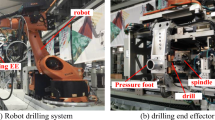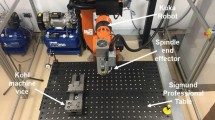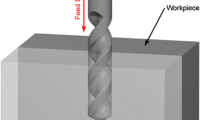Abstract
Industrial robot due to its high flexibility and low cost is wildly used in many areas. However, the low stiffness properties are the main limitation to the application of industrial robots in the field of precision machining. This paper addresses a modeling method of the Cartesian compliance for a drilling robot. The stiffness characterization in the drilling axial direction is analyzed, and the diversity of the axial stiffness in different robot postures is investigated. Based on the Cartesian compliance model, a quantitative evaluation index of the robot drilling performance is defined. Finally, experiments were developed on KUKA KR500-2 robot to validate the correctness of the model proposed, and specific conclusions regarding the robot compliance characterization are presented.
Similar content being viewed by others
References
International Federation of Robotics (2013) World Robotics 2012, Statistical Yearbook
Schneider U, Drust M, Ansaloni M, Lehmann C, Pellicciari M, Leali F, Gunnink JW, Verl A (2016) Improving robotic machining accuracy through experimental error investigation and modular compensation. Int J Adv Manuf Technol 85:3–15
J. Choi, S. Min, D. A. Dornfeld, M. Alam and T. Tzong (2003) Modeling of inter-layer gap formation in drilling of a multi-layered material. In: Proc. 6th CIRP Workshop on Modeling of Machining, McMaster University, Hamilton, pp.36–41
Abele E, Weigold M, Rothenbucher S (2007) Modeling and identification of an industrial robot for machining applications. Annals of the CIRP 1(56):387–390
Chen S-F, Kao I (2000) Conservative congruence transformation for joint and Cartesian stiffness matrices of robot hands and figures. The International Journal of Robotics Research 9(19):835–847
Dumas C, Caro S, Garnier S, Furet B (2011) Joint stiffness identification of six-revolute industrial serial robots. Robot Comput Integr Manuf 27:881–888
Dumas C, Caro S, Garnier S, Furet B (2012) Joint stiffness identification of industrial serial robots. Robotica 4(30):649–659
Pan Z, Zhang H, Zhu Z, Wang J (2006) Chatter analysis of robotic machining process. J Mater Process Technol 173:301–309
Mejri S, Gagnol V, Le T-P, Sabourin L, Ray P, Paultre P (2016) Dynamic characterization of machining robot and stability analysis. Int J Adv Manuf Technol 82:351–359
Abele E, Schutzer K, Pischan M (2012) Tool path adaption based on optical measurement data for milling with industrial robot. Prod. Eng. Res. Devel. 6:459–465
Vosniakos G-C, Matsas E (2010) Improving feasibility of robotic milling through robot placement optimization. Robot Comput Integr Manuf 26:517–525
Slamani M, Gauthier S, Chatelain J-F (2015) A study of the combined effects of machining parameters on cutting force components during high speed robotic trimming of CFRPs. Measurement 59:268–283
Zaeh MF, Roesch O (2014) Improvement of the machining accuracy of milling robots. Prod. Eng. Res. Devel. 8:737–744
Hofener M, Schuppstuhl T (2014) A method for increasing the accuracy of “on-workpiece” machining with small industrial robots for composite repair. Prod Eng Res Devel 8:701–709
Klimchik A, Furet B, Caro S, Pashkevich A (2015) Identification of the manipulators stiffness model parameters in industrial environment. Mech Mach Theory 90:1–22
DeVlieg R, Sitton K, Feikert E and Inman J (2002) ONCE (one sided cell end effector) robotic drilling system. In: SAE 2002 Automated Fastening Conference & Exposition, Chester, ENGLA. SAE Technical Papers 2002–01-2626
Liang J (2013) The formation and effect of interlayer gap in dry drilling of stacked metal materials. Int J Adv Manuf Technol 69:1263–1272
Guo Y, Dong H, Ke Y (2015) Stiffness-oriented posture optimization in robotic machining applications. Robot Comput Integr Manuf 35:69–76
Yin B, TianWei LWH, Hu J, **n S (2015) Investigation of correlation between interlayer gap and burr height in drilling of stacked Al-7475 materials. Proc IMechE Part B: Journal of Engineering Manufacture. doi:10.1177/0954405415617671
Yoshikawa T (1990) Foundations of robotics-analysis and control. The MIT Press, Cambridge, Massachusetts, London, England
K S. ARUN, T. S. HUANG and S. D. BLOSTEIN (1987) Least-squares fitting of two 3-D point sets. IEEE Transactions on Pattern Analysis and Machine Intelligence:698–700
Author information
Authors and Affiliations
Corresponding authors
Ethics declarations
Funding
This work was supported by the Chinese Fundamental Research Funds for the Central Universities (Grant No. NS2015052).
Rights and permissions
About this article
Cite this article
BU, Y., LIAO, W., TIAN, W. et al. Modeling and experimental investigation of Cartesian compliance characterization for drilling robot. Int J Adv Manuf Technol 91, 3253–3264 (2017). https://doi.org/10.1007/s00170-017-9991-z
Received:
Accepted:
Published:
Issue Date:
DOI: https://doi.org/10.1007/s00170-017-9991-z




